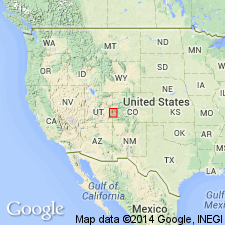
- Usage in publication:
-
- Pariott member*
- Modifications:
-
- Original reference
- Dominant lithology:
-
- Sandstone
- Mudstone
- Siltstone
- Shale
- AAPG geologic province:
-
- Paradox basin
Summary:
Pg. 1838-1839, 1842, 1847-1848. Pariott member of Moenkopi formation. Consists of red-brown to purplish-brown sandstone and chocolate-brown, orange, and red mudstone, siltstone, and shale. Thickness at type section 134 feet; 252 feet in Sinbad Valley, southwestern Colorado; thickens abruptly toward the west and is several hundred feet thick where it dips beneath the surface beyond northwest end of Castle Valley, southwestern Utah, where it is overlain by a lens of gray silty conglomeratic sandstone assigned by Baker (1933, USGS Bull. 841) to Shinarump conglomerate and by Dane (1935, USGS Bull. 863) to Chinle formation. Overlies Sewemup member (new); unconformably underlies Chinle formation and in some areas truncated by it. [Age is Middle(?) Triassic.]
Type section: south side Pariott Mesa, in sec. 5, T. 25 N., R. 23 E., Grand Co., southwestern UT.
Source: US geologic names lexicon (USGS Bull. 1200, p. 2924).
For more information, please contact Nancy Stamm, Geologic Names Committee Secretary.
Asterisk (*) indicates published by U.S. Geological Survey authors.
"No current usage" (†) implies that a name has been abandoned or has fallen into disuse. Former usage and, if known, replacement name given in parentheses ( ).
Slash (/) indicates name conflicts with nomenclatural guidelines (CSN, 1933; ACSN, 1961, 1970; NACSN, 1983, 2005, 2021). May be explained within brackets ([ ]).

